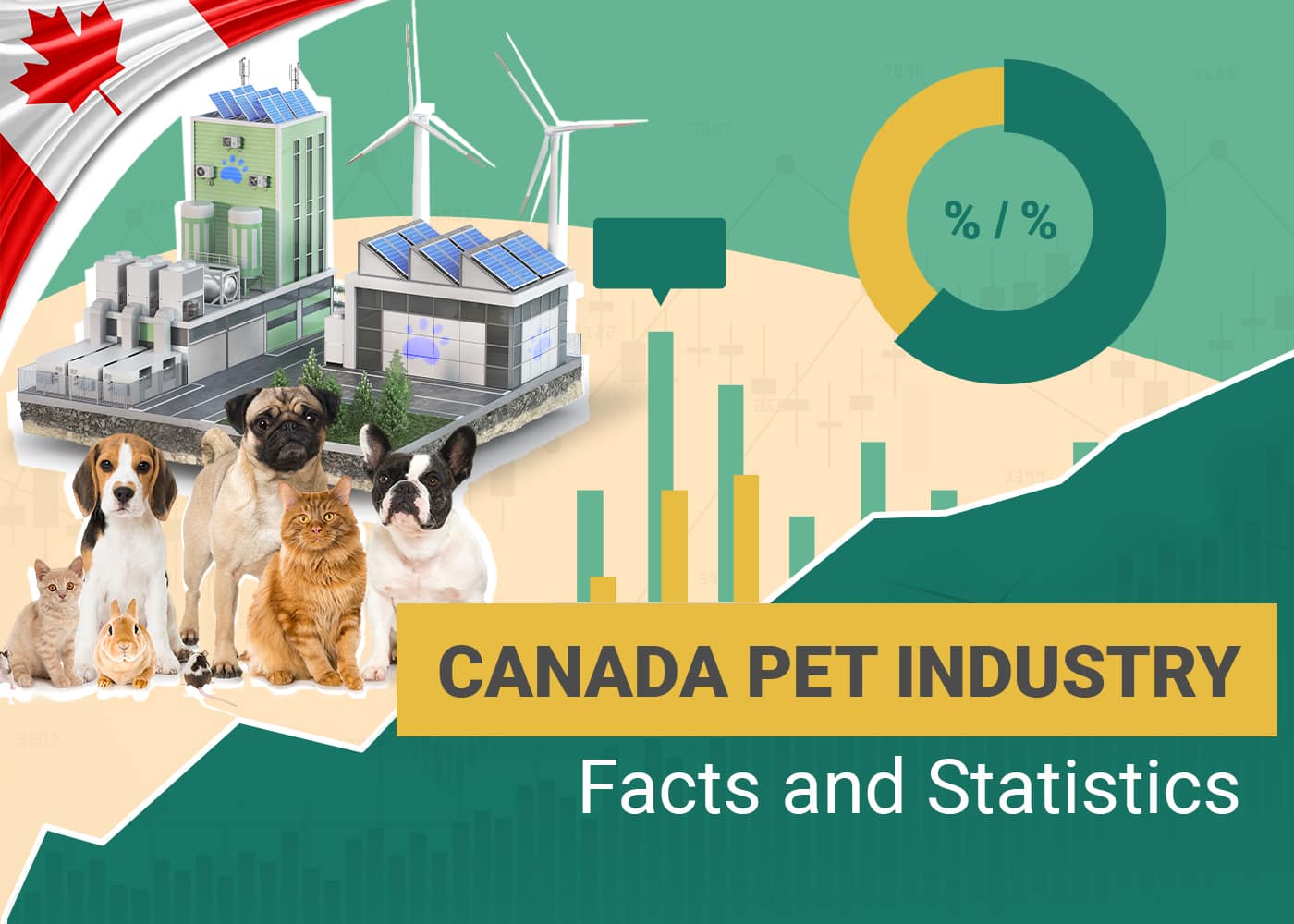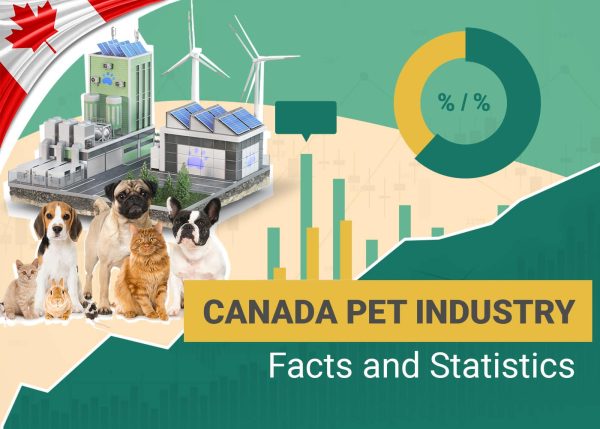Click to Skip Ahead
Note: This article’s statistics come from third-party sources and do not represent the opinions of this website.
Canadians love their pets! There are so many different reasons for keeping a pet. They can help with anxiety, stress, and depression, relieve feelings of loneliness, provide motivation for exercise, and improve physical and mental well-being. Pets can help teach children responsibility and the meaning of unconditional love. Canada’s pet industry statistics prove just how big the pet industry is and provide valuable information on how Canadians are doing with their companion animals.
The 27 Canada Pet Industry Statistics
- Ontario has the largest number of pet supply stores, totaling 758 stores in 2020.
- In 2020, wet dog food sales totaled $197 million, while wet cat food totaled $394 million.
- PetSmart is the top pet supply store, with 92% of its 1,650 North American stores located in Canada.
- Online pet stores only accounted for 21.7% of Canadian pet sales in 2020.
- 5% of Canadians are willing to pay more for healthy pet food.
- Only 10.45% of Canadian pet owners choose organic food.
- 58% of Canadians are pet owners.
- Canadian regions are divided by their preference for cats or dogs.
- 5 million households in Canada own pets.
- Alberta has the highest rate of pet ownership at 63%.
- Less than 3% of pet owners have pet insurance.
- 4 million wild animals are kept as pets in Canada.
- Ontario alone has 588,652 wild animals kept as pets.
- 77% of Canadian pet owners buy food in-store.
- Dry cat food sales totaled $250.9 million in 2018.
- Meal and kibbled dog food sales totaled $359.13 million in 2018.
- Only 10.45% of pet owners buy organic food.
- Based on current pet ownership trends, Canada’s pet food market is expected to grow by 4.3% between 2020 and 2025.
- Dry pet food accounts for approximately 32% of the pet food market.
- The average annual household expenditure on pets in 2017 was $631.
- 60% of pet owners choose their pet’s food based on what their pet likes.
- The average cost of dog food in Canada is $1,083 per year.
- In 2020, the annual cost of professional dental care for cats was $582.
- Canadians spent over $9 billion on pets, pet food, and veterinary care in 2019.
- The growth of the pet grooming and boarding industry has grown by 3.7% per year between 2015 and 2020.
- Dental care is the second most common health issue for pets in Canada, but only 16% of pet owners are proactive about it.
- 55% of dogs and 70% of cats don’t receive enough exercise.
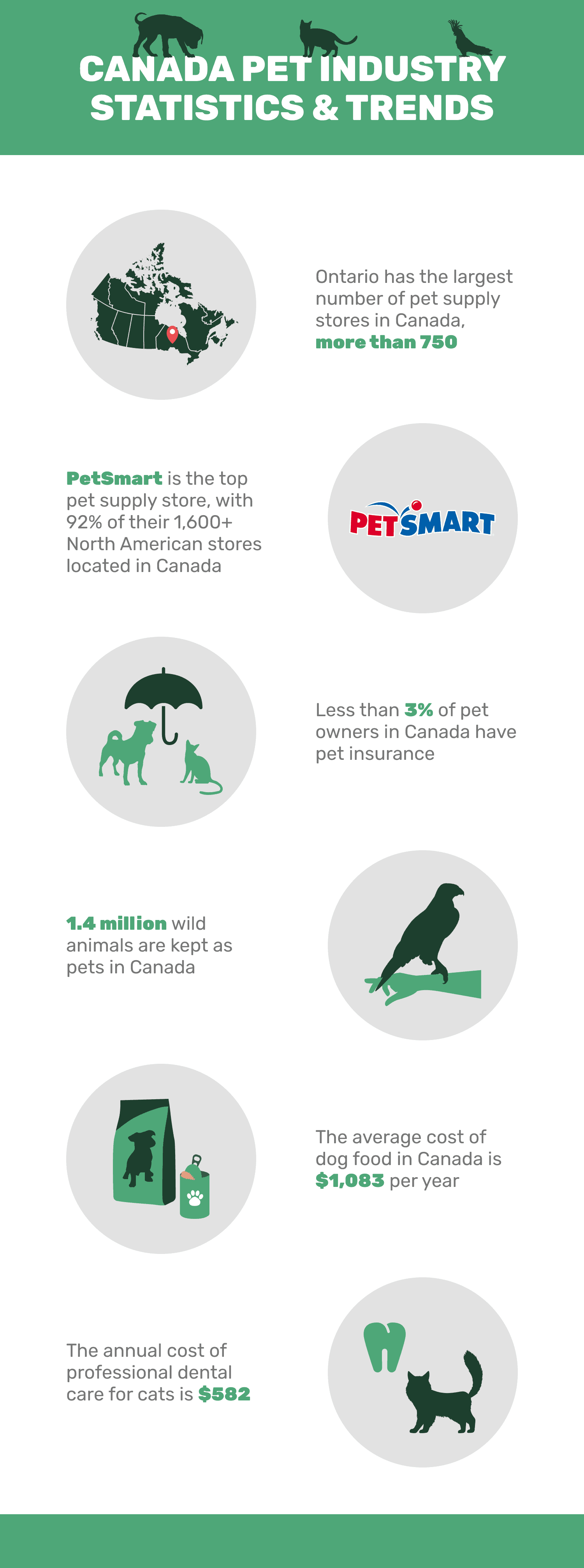
General Canada Pet Industry Statistics
1. Ontario has the largest number of pet supply stores, totaling 758 stores in 2020.
(Statista)
Quebec follows second with 487, British Columbia has 352, and Alberta has 269. The fewest number is located in the Northwest Territories, which only report two stores. This, of course, is in part to the remote nature of the area.

2. In 2020, wet dog food sales totaled $197 million, while wet cat food totaled $394 million.
(Statista)
Canadian dogs clearly prefer dry food, as dry dog food sales were close to $2 billion. Dry cat food totaled $841 million. Also, dogs are more likely to be fed treats, apparently. Cat treat sales were only $149 million in 2020, but dog food treats raked in about $500 million.
3. PetSmart is the top pet supply store, with 92% of their 1,650 North American stores located in Canada.
(Statista)
There are tons of different pet stores in Canada, including Petland, PETCO, and Pet Valu, but PetSmart and PETCO clearly have the market cornered with 1,650 and 1,559 stores, respectively.
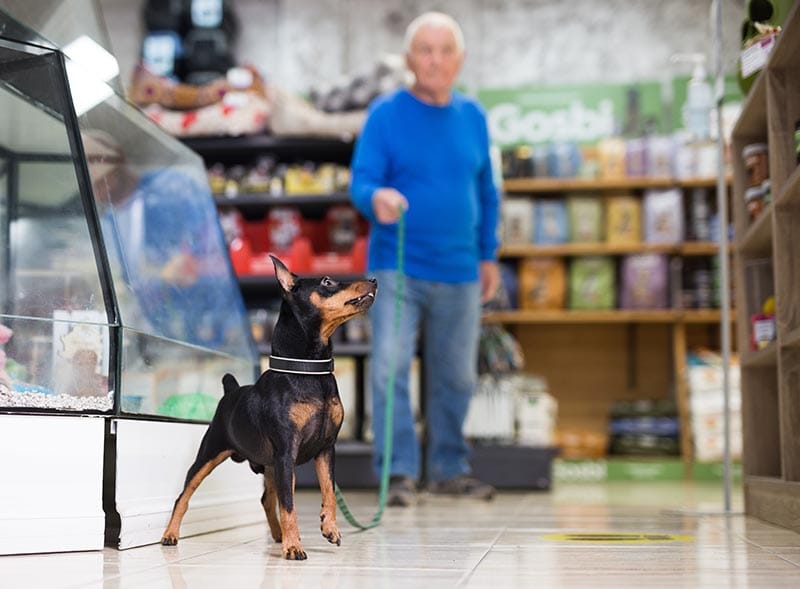
4. Online pet stores only accounted for 21.7% of Canadian pet sales in 2020.
(Statista)
This is a huge surprise, given the prevalence of pandemic lockdowns over the course of the year. 76.6% of Canadian pet owners still flocked to brick-and-mortar stores for pet food and shopped for other pet supplies in store.
5. 5% of Canadians are willing to pay more for healthy pet food.
35.6% were unsure, while 21.9% said that they wouldn’t switch foods.

6. Only 10.45% of Canadian pet owners choose organic food.
(Statista)
Products with “natural” ingredients are becoming more common, with Blue Buffalo, Nature’s Variety, and Natural Balance among the most popular brands. Imported natural ingredient pet food from the U.S. increased from $790 million in 2012 to over $1 billion in 2016.
Pet Ownership Statistics

7. 58% of Canadians are pet owners.
(Pet Food Association of Canada)
- Canada’s dog population grew from 7.6 million in 2018 to 7.7 million in 2020.
- The cat population is about 8.1 million.
- Approximately 855,000 Canadians own horses, with the current population sitting around 963,500.
- Birds are the most popular exotic pet, followed by wild cats, snakes, turtles and tortoises, wild dogs, amphibians, arachnids, crocodiles, and alligators!
8. Canadian regions are divided by their preference for cats or dogs.
(Statistics Canada)
Nova Scotia and Quebec residents are most likely to be dog owners, while urban residents of British Columbia and the prairie provinces are more likely to have cats.

9. 5 million households in Canada own pets.
(PetBacker)
- Sugar gliders — These marsupials have a gliding membrane that enables them to “fly” through the air.
- Wallabies — These little critters are popular in Alberta. They grow to be about 50 pounds and 30–36 inches tall. They can be trained to a certain extent in domestic environments.
- Pygmy goats — While goats can only be kept in agricultural areas, they make energetic and delightful pets.
- Servals — Most provinces allow ownership of these wild Savannah cats but only for certain generations. Alberta, for example, only allows F4 generations or lower. These cats can grow to weigh approximately 40 pounds.
10. Alberta has the highest rate of pet ownership at 63%.
(Pawzy)
This could be due to the high percentage of rural areas, as British Columbia and Saskatchewan follow close behind at 55% and 56%.
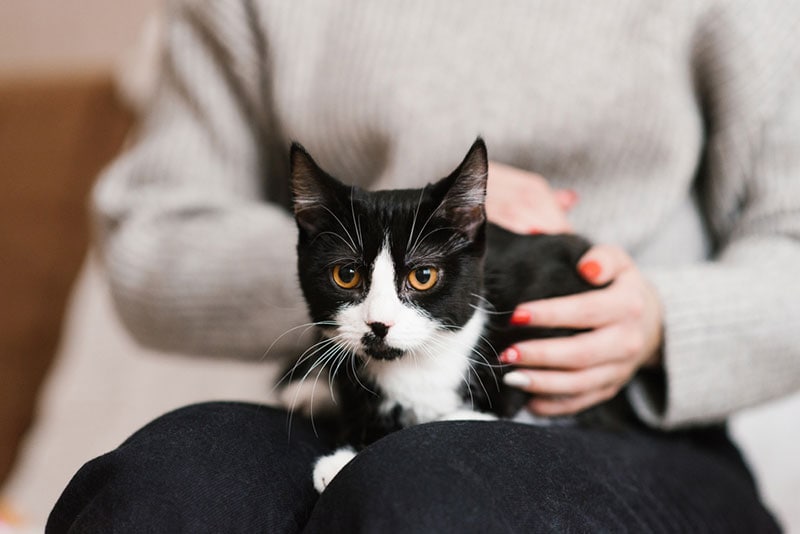
11. Less than 3% of pet owners have pet insurance.
(Insurance Institute)
While the Canadian pet insurance industry is worth about $595 million, few owners buy into it. For comparison’s sake, pet insurance is purchased by 25% to 30% of pet owners in the U.K., and Sweden has approximately 50% of their pets insured.
Exotic Pet Statistics
12. 4 million wild animals are kept as pets in Canada.
(World Animal Protection)
478,648 of these are tropical birds like cockatoos and parrots; wild cats like servals and caracals number 186,104. Wild dogs include dingoes and fennec foxes. Someone somewhere in Canada keeps crocodiles and alligators as pets too!
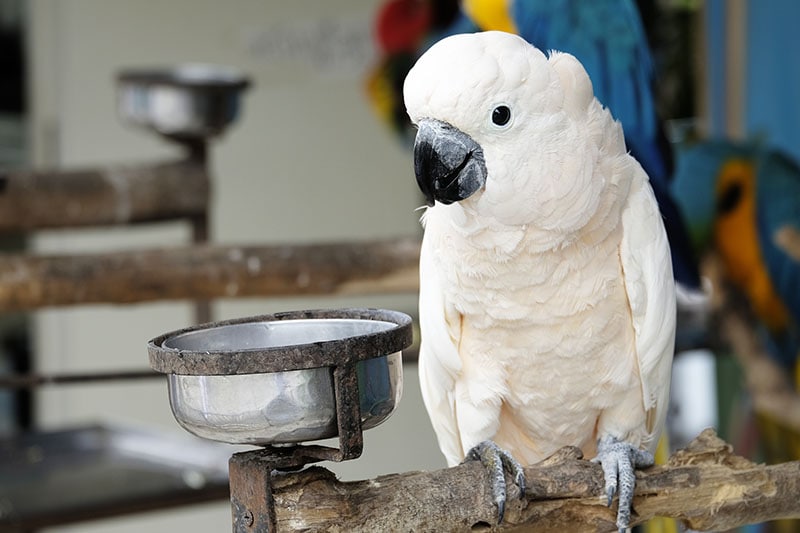
13. Ontario alone has 588,652 wild animals kept as pets.
(World Animal Protection)
Quebec has 286,693, followed by Alberta, B.C., Manitoba, and Saskatchewan. The Atlantic provinces hold 73,534 wild animal pets.
Pet Food Statistics
14. 77% of Canadian pet owners buy food in-store.
(Statista)
Only 7.23% report regularly buying pet food online.

15. Dry cat food sales totaled $250.9 million in 2018.
(Statista)
Sales of cat treats totaled $73.38 million, and canned cat food totaled $199.21 million.
16. Meal and kibbled dog food sales totaled $359.13 million in 2018.
(Statista)
Treat sales amounted to an estimated $227 million, while canned dog food sales equaled $101.73 million.
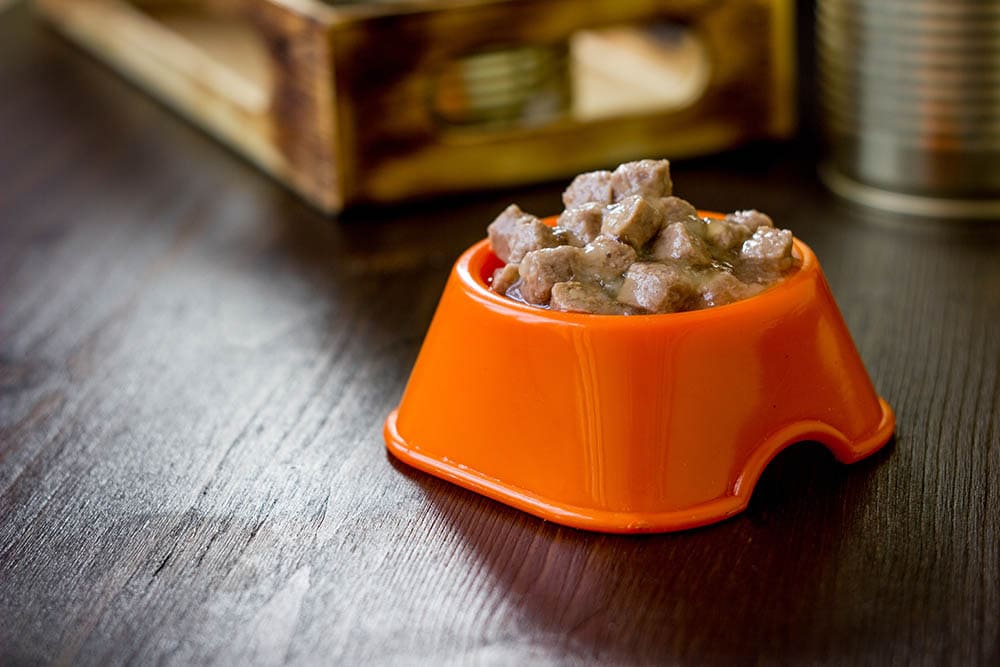
17. Only 10.45% of pet owners buy organic food.
(Statista)
Stated reasons for buying traditional pet food include availability and lower price.
18. Based on current pet ownership trends, Canada’s pet food market is expected to grow by 4.3% between 2020 and 2025.
(Mordor Intelligence)
As more and more pets become family members, more people are looking for high-quality food products.
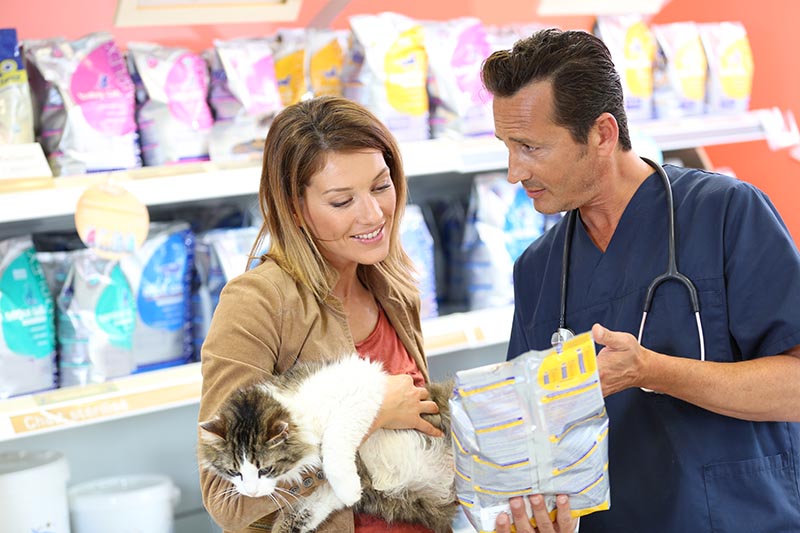
19. Dry pet food accounts for approximately 32% of the pet food market.
(Mordor Intelligence)
While there are countless pet food formulations for owners to choose from, dry food is preferred due to its convenience.
Canadian Pet Spending Statistics
20. The average annual household expenditure on pets in 2017 was $631.
(Statista)
This spending has been steadily rising since 2010.

21. 60% of pet owners choose their pet’s food based on what their pet likes.
(Canada’s Pet Wellness Report)
Only 33% of pet owners purchase food to meet health requirements, despite 70% of vets proactively discussing proper nutrition with owners.
22. The average cost of dog food in Canada is $1,083 per year.
(Statista)
Food is the leading pet expense, followed by dental care and pet insurance, which cost owners $582 and $979, respectively.

23. In 2020, the annual cost of professional dental care for cats was $582.
(Statista)
Cat food was more affordable than dog food, costing about $490 per year. Other cat owner expenses included litter ($180/year), vaccinations ($162/year), and flea prevention ($131/year).
24. Canadians spent over $9 billion on pets, pet food, and veterinary care in 2019.
(Statistics Canada)
This compares to the spending of only $7.2 billion in 2015.

25. The growth of the pet grooming and boarding industry has grown by 3.7% per year between 2015 and 2020.
(IBISWorld)
The pet boarding industry has been the hardest hit by the pandemic due to reduced demand.
Pet Wellness Statistics
26. Dental care is the second most common health issue for pets in Canada, but only 16% of pet owners are proactive about it.
(Canada’s Pet Wellness Report)
While vets consider clean teeth a marker of good overall health, it doesn’t even rank in the top 10 signs that pet owners use to judge their pet’s health.

27. 55% of dogs and 70% of cats don’t receive enough exercise.
(Canada’s Pet Wellness Report)
Canadian pet owners spend about three times as much time watching TV as they do exercising their pets on the average weekday. While this statistic sounds alarming, it’s important to note that most parts of the country are in the dark for approximately 15 hours of the day in winter, even in the most southern locations. Combine this with frigid temperatures and high amounts of snow during these months, and there may be more to a pet’s lack of exercise than just having a lazy owner.
Frequently Asked Questions
How Much Is the Canadian Pet Industry Worth?
The Canadian pet market has a net worth of US$7 billion. This is expected to grow at an annual rate of 4.3% by 2025. (Government of Canada)

What Are the Biggest Challenges That the Canadian Pet Industry Faces?
The biggest challenges currently faced within the Canadian pet industry are competition from e-commerce-only retailers, industry consolidation, and increased demand for healthy food options. Pet owners are looking for more food variety for their pets, particularly foods that are designed to address health concerns.
Is Canada’s Pet Industry Competitive?
2021 metrics show the pet industry as one of the most lucrative online markets in Canada. There is intense competition in the pet care, pet food, and pet supply niches, particularly by mass merchandisers that profit from high-volume, low-price sales.
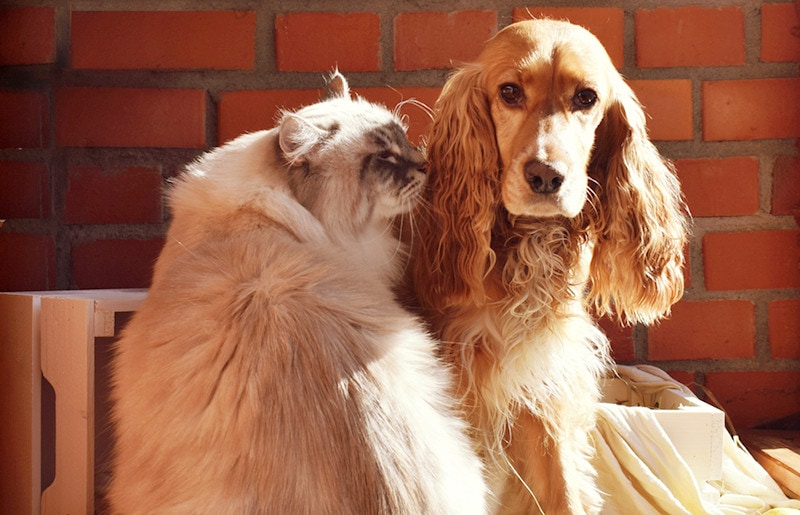
What Is the Most Common Pet in Canada?
The most popular pet in Canada is a dog. 41% of Canadian households own a dog, while 37% own cats. (World Atlas)
Conclusion
Pet statistics show that Canada is an animal-loving country, with the majority of households owning a pet. Most of these pets are dogs and cats. However, there is also a large number of exotic pets. There are improvements to be made in improving pet wellness. Factors preventing this from being a priority include geographical location, cost of healthy food, and knowledge of health indicators.
Related Reads:
Featured Image Credit: Tatyana Vyc, Shutterstock

